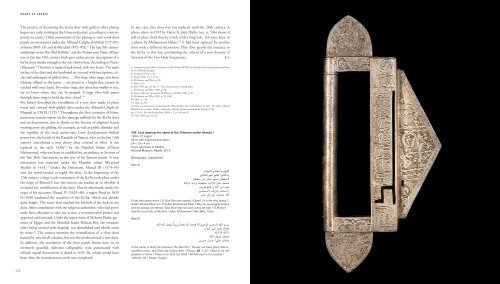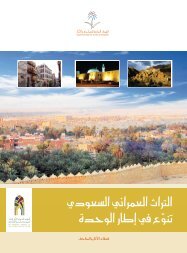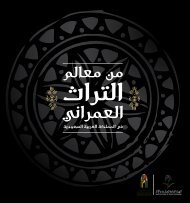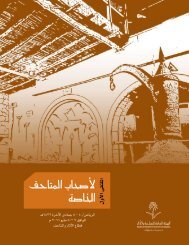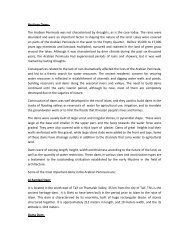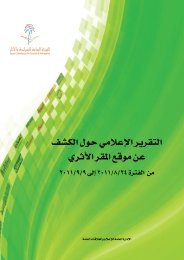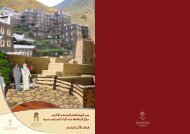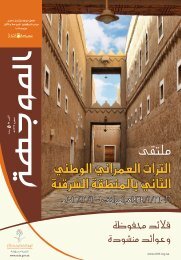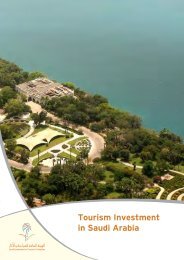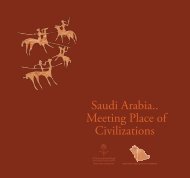Roads of Arabia
Roads of Arabia
Roads of Arabia
You also want an ePaper? Increase the reach of your titles
YUMPU automatically turns print PDFs into web optimized ePapers that Google loves.
34 Arabie US p522-545_BAT.qxd 23/06/10 21:30 Page 538<br />
ROADS OF ARABIA<br />
The practice <strong>of</strong> decorating the Ka‘ba door with gold or silver plating<br />
began very early, starting in the Umayyad period, according to contemporary<br />
accounts. 5 Other renovations <strong>of</strong> the plating or teak wood door<br />
panels are mentioned under the Abbasid Caliphs al-Mahdi (775–85),<br />
al-Amin (809–13) and al-Mu‘tadid (892–902). 6 The late 9th century<br />
andalusian writer Ibn ‘Abd Rabbihi 7 and the Persian poet Nasir-i Khusraw<br />
in the late 10th century both gave rather precise descriptions <strong>of</strong> a<br />
Ka‘ba door similar enough to the one shown here. According to Nasiri<br />
Khusraw, “This door is made <strong>of</strong> teak wood, with two leaves. The main<br />
surface <strong>of</strong> the door and the baseboard are covered with inscriptions, circles<br />
and arabesques <strong>of</strong> gilded silver.... Two large silver rings, sent from<br />
Ghazna, affixed to the leaves... are placed at a height that cannot be<br />
reached with one’s hand. Two other rings, also silver but smaller in size,<br />
are set lower where they can be grasped. A large silver bolt passes<br />
through these rings to hold the door closed”. 8<br />
Ibn Jubayr described the installation <strong>of</strong> a new door made <strong>of</strong> plane<br />
wood and covered with gilded silver under the Abbasid Caliph al-<br />
Muqtafi in 550 H./1155. 9 Throughout the first centuries <strong>of</strong> Islam,<br />
numerous sources report on the damage suffered by the Ka‘ba door<br />
and its decorations, due to floods or the friction <strong>of</strong> pilgrims’ hands<br />
wearing away the gilding, for example, as well as public disorder and<br />
the cupidity <strong>of</strong> the local authorities. Later developments shifted<br />
power into the hands <strong>of</strong> the Rasulids <strong>of</strong> Yemen, who in the late 13th<br />
century contributed a new ebony door covered in silver. It was<br />
replaced in the early 1330s 10 by the Mamluk Sultan al-Nasir<br />
Muhammad, who was keen to establish his ascendancy as Servant <strong>of</strong><br />
the Two Holy Sanctuaries in the eyes <strong>of</strong> his Yemeni vassals. A new<br />
renovation was reported under the Mamluk sultan Mu‘ayyad<br />
Shaykh in 1414. 11 Under the Ottomans, Murad III (1574–95)<br />
sent the metal needed to regild the door. At the beginning <strong>of</strong> the<br />
17th century a large–scale restoration <strong>of</strong> the Ka‘ba took place under<br />
the reign <strong>of</strong> Ahmad I, but the sources are unclear as to whether it<br />
included any modification <strong>of</strong> the door. Shortly afterwards, under the<br />
reign <strong>of</strong> his successor Murad IV (1623–40), a major flood in 1039<br />
H./1630 weakened the structure <strong>of</strong> the Ka‘ba, which was already<br />
quite fragile. The water level reached the keyhole <strong>of</strong> the lock on the<br />
door. After consultation with the religious authorities, who had previously<br />
been reluctant to take any action, a reconstruction project was<br />
approved and initiated. Under the supervision <strong>of</strong> Mehmet Pasha, governor<br />
<strong>of</strong> Egypt, and the Mamluk leader Ridwan Bey, the structure<br />
(after being covered with draping) was demolished and rebuilt stone<br />
by stone. 12 The sources mention the reinstallation <strong>of</strong> a silver door<br />
framed by two small columns, but not the production <strong>of</strong> a new door.<br />
In addition, the inscription <strong>of</strong> the door panels shown here, in an<br />
extremely graceful, elaborate calligraphic style punctuated with<br />
refined vegetal decorations, is dated to 1635–36, which would have<br />
been after the reconstruction work was completed.<br />
In any case, this door was not replaced until the 20th century. A<br />
photo taken in 1937 by Harry St John Philby (see p. 536) shows it<br />
still in place, held shut by a lock with a long bolt. Ten years later, in<br />
a photo by Muhammad Helmy, 13 it had been replaced by another<br />
door with a different decoration. That door guards the entrance to<br />
the Ka‘ba to this day, proclaiming the advent <strong>of</strong> a new dynasty <strong>of</strong><br />
Servants <strong>of</strong> the Two Holy Sanctuaries. C. J.<br />
1. I express my gratitude to Pr<strong>of</strong>essor Ludvik Kalus (EPHE) for his help in the reading and translation<br />
<strong>of</strong> two difficult passages.<br />
2. Göyünç 1979, p. 178.<br />
3. Tazjan 1996, nos 1 to 11.<br />
4. El-Hawary and Wiet, p. 28.<br />
5. Ibid., p. 35.<br />
6. Ibid. 1985, pp. 66, 68, 77. They also mention sending locks.<br />
7. El-Hawary and Wiet 1985, p. 78.<br />
8. Nasir-i-Khusraw, quoted in El-Hawary and Wiet 1983, p. 91.<br />
9. El-Hawary and Wiet 1985, p. 99–100.<br />
10. Ibid., p. 148.<br />
11. Ibid., p. 201.<br />
12. This reconstruction was described by Evliya Celebi, who visited Mecca in 1671–72, and by Sühayli<br />
Efendi in his Tarikh-i Mekke-i mükerrime (Risale); references quoted by Faroqhi 1994,<br />
pp. 113–16. See also Eyyüp Sabri 2004, t. 1, p. 449 and ff.<br />
13. Paris 2005, pp. 92–93.<br />
306. Lock bearing the name <strong>of</strong> the Ottoman sultan Ahmad I<br />
1603–17 (reign)<br />
Silver with engraved decoration<br />
24 x 12 x 4 cm<br />
Hujra, sanctuary <strong>of</strong> Medina<br />
National Museum, Riyadh, 3013<br />
Bibliography: unpublished.<br />
Side A:<br />
O key that opens doors / O God (He who opens) / Open! / It is He who opens /<br />
Sultan Ahmad Khan son <strong>of</strong> Sultan Muhammad Khan / May his sovereignty endure<br />
and his dynasty be eternal / May God help him and victory be near / O Muhammad<br />
the most l<strong>of</strong>ty <strong>of</strong> Muslims / Allah, Muhammad / Abu Bakr, ‘Umar<br />
Side B:<br />
In the name <strong>of</strong> God, the Clement, the Merciful / “Surely, we have given thee a<br />
manifest victory, that God may forgive thee.” (Quran, 48, 1–2) / Open to us the<br />
greatest <strong>of</strong> doors / There is no God but Allah / Muhammad is his prophet /<br />
‘Uthman ‘Ali / Hasan Husayn<br />
538


